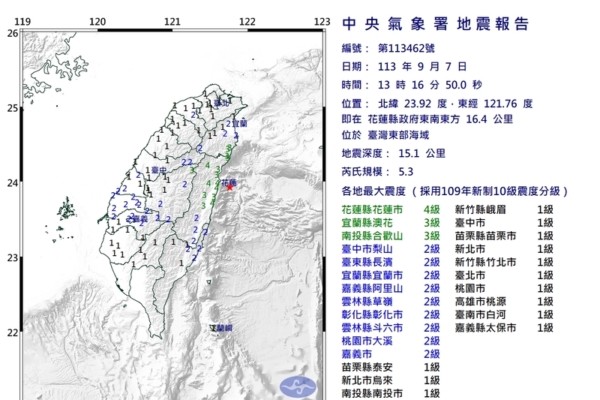The Taiwan Central Weather Bureau of the Ministry of Transportation of the Republic of China announced that at 1:16 pm today (7th), an earthquake with a Richter magnitude of 5.3 occurred at a depth of 15.1 kilometers, 16.4 kilometers southeast of the Hualien County government in the southeast of Taiwan (located in the eastern sea area of Taiwan). The maximum seismic intensity in Hualien County reached level 4.
According to the Taiwan Central Weather Bureau, areas with intensity level 4 include Hualien County, level 3 includes Yilan County and Nantou County, level 2 includes Taichung City, Taitung County, Chiayi County, Yunlin County, Changhua County, Taoyuan City, and Chiayi City, while level 1 includes Miaoli County, New Taipei City, Hsinchu County, Taipei City, Kaohsiung City, and Tainan City.
The Taiwan Central Weather Bureau further reported that a Richter magnitude 4.8 earthquake occurred at 5:28 am today, with a depth of 48.6 kilometers and an epicenter located 35.7 kilometers northeast of the Hualien County government (in the nearshore area of Hualien County). The maximum seismic intensity reached level 3 in Hualien County and Yilan County.
These seismic activities have raised concerns among local residents and officials as Taiwan is located in a seismically active region. The authorities are closely monitoring the situation and advising residents to stay vigilant and be prepared for possible aftershocks. Earthquakes are frequent occurrences in Taiwan due to its location on the Pacific Ring of Fire and the complex tectonic movement in the region.
Efforts to enhance earthquake preparedness and response, such as early warning systems and emergency drills, are ongoing in Taiwan to mitigate the impact of seismic events. The coordination between local authorities, emergency services, and the public is crucial in ensuring a prompt and effective response in the event of natural disasters like earthquakes.
As seismologists continue to monitor the seismic activity in the region, it is essential for residents to follow safety guidelines and stay informed about the latest updates from official sources. By staying informed and prepared, individuals can better protect themselves and their communities in the face of potential natural disasters.

